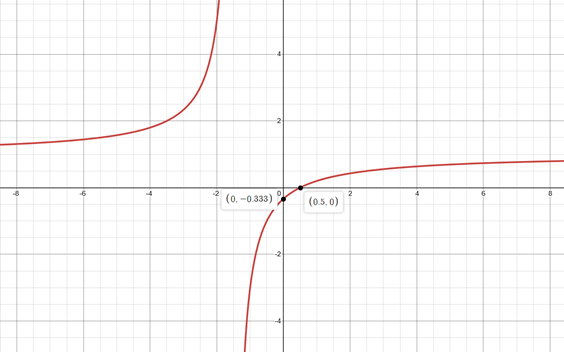
Concept explainers
To find the asymptotes and holes of the function
Answer to Problem 67E
Explanation of Solution
Given:
Function:
Calculation:
Intercepts:
Let
To find x intercepts, put y = 0,
So, x intercept is (0.5, 0).
To find y intercepts, put x = 0,
So, y intercept is (0, 0.333).
Asymptotes:
Vertical asymptotes:
To find vertical asymptotes, put denominator of the given function equal to zero.
Horizontal asymptotes:
As the degree of numerator is equal to the degree of the denominator, the horizontal asymptote is
Slant asymptotes:
As the degree of numerator is equal to the degree of the denominator, the slant asymptote does not exist for given function.
Holes:
Here, the given function contains one common factor in numerator and denominator i.e..,
To find hole of the function, equate common factor equal to zero.
So, the hole of function is
Calculation for graph:
Consider
| Values of x | Values of f (x) |
| 0 | -0.333 |
| 1 | 0.2 |
| -1 | -3 |
| 2 | Undefined |
| -2 | 5 |
By taking different values of x, the graph can be plotted.
Graph:

Interpretation:
By observing graph, it is clear that
The x intercept is (0.5, 0),
The y intercept is (0, 0.333),
The vertical asymptotes are
The horizontal asymptote is
Chapter 2 Solutions
Precalculus with Limits: A Graphing Approach
- A 20 foot ladder rests on level ground; its head (top) is against a vertical wall. The bottom of the ladder begins by being 12 feet from the wall but begins moving away at the rate of 0.1 feet per second. At what rate is the top of the ladder slipping down the wall? You may use a calculator.arrow_forwardExplain the focus and reasons for establishment of 12.4.1(root test) and 12.4.2(ratio test)arrow_forwarduse Integration by Parts to derive 12.6.1arrow_forward
- Explain the relationship between 12.3.6, (case A of 12.3.6) and 12.3.7arrow_forwardExplain the key points and reasons for the establishment of 12.3.2(integral Test)arrow_forwardUse 12.4.2 to determine whether the infinite series on the right side of equation 12.6.5, 12.6.6 and 12.6.7 converges for every real number x.arrow_forward
- use Corollary 12.6.2 and 12.6.3 to derive 12.6.4,12.6.5, 12.6.6 and 12.6.7arrow_forwardExplain the focus and reasons for establishment of 12.5.1(lim(n->infinite) and sigma of k=0 to n)arrow_forwardExplain the focus and reasons for establishment of 12.5.3 about alternating series. and explain the reason why (sigma k=1 to infinite)(-1)k+1/k = 1/1 - 1/2 + 1/3 - 1/4 + .... converges.arrow_forward
 Calculus: Early TranscendentalsCalculusISBN:9781285741550Author:James StewartPublisher:Cengage Learning
Calculus: Early TranscendentalsCalculusISBN:9781285741550Author:James StewartPublisher:Cengage Learning Thomas' Calculus (14th Edition)CalculusISBN:9780134438986Author:Joel R. Hass, Christopher E. Heil, Maurice D. WeirPublisher:PEARSON
Thomas' Calculus (14th Edition)CalculusISBN:9780134438986Author:Joel R. Hass, Christopher E. Heil, Maurice D. WeirPublisher:PEARSON Calculus: Early Transcendentals (3rd Edition)CalculusISBN:9780134763644Author:William L. Briggs, Lyle Cochran, Bernard Gillett, Eric SchulzPublisher:PEARSON
Calculus: Early Transcendentals (3rd Edition)CalculusISBN:9780134763644Author:William L. Briggs, Lyle Cochran, Bernard Gillett, Eric SchulzPublisher:PEARSON Calculus: Early TranscendentalsCalculusISBN:9781319050740Author:Jon Rogawski, Colin Adams, Robert FranzosaPublisher:W. H. Freeman
Calculus: Early TranscendentalsCalculusISBN:9781319050740Author:Jon Rogawski, Colin Adams, Robert FranzosaPublisher:W. H. Freeman
 Calculus: Early Transcendental FunctionsCalculusISBN:9781337552516Author:Ron Larson, Bruce H. EdwardsPublisher:Cengage Learning
Calculus: Early Transcendental FunctionsCalculusISBN:9781337552516Author:Ron Larson, Bruce H. EdwardsPublisher:Cengage Learning





